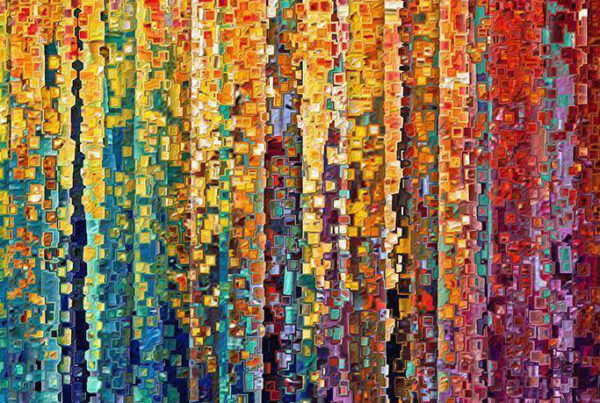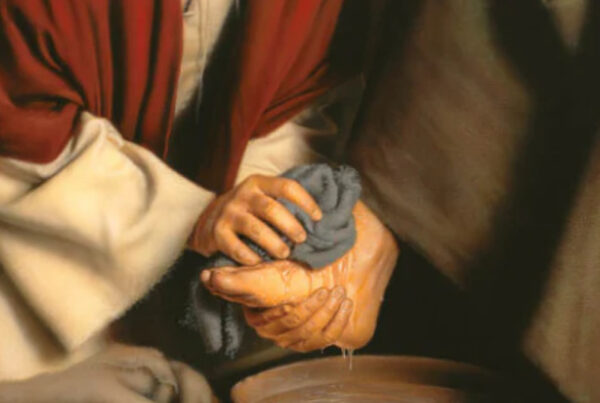The Book of Mark
Chapter 11
As they approached Jerusalem and came to Bethphage and Bethany at the Mount of Olives, Jesus sent two of his disciples, saying to them, “Go to the village ahead of you, and just as you enter it, you will find a colt tied there, which no one has ever ridden. Untie it and bring it here. If anyone asks you, ‘Why are you doing this?’ say, ‘The Lord needs it and will send it back here shortly.’”
They went and found a colt outside in the street, tied at a doorway. As they untied it, some people standing there asked, “What are you doing, untying that colt?” They answered as Jesus had told them to, and the people let them go. When they brought the colt to Jesus and threw their cloaks over it, he sat on it. Many people spread their cloaks on the road, while others spread branches they had cut in the fields. Those who went ahead and those who followed shouted,
“Hosanna!”
“Blessed is he who comes in the name of the Lord!”
“Blessed is the coming kingdom of our father David!”
“Hosanna in the highest heaven!”
Jesus entered Jerusalem and went into the temple courts. He looked around at everything, but since it was already late, he went out to Bethany with the Twelve.
The next day as they were leaving Bethany, Jesus was hungry. Seeing in the distance a fig tree in leaf, he went to find out if it had any fruit. When he reached it, he found nothing but leaves, because it was not the season for figs. Then he said to the tree, “May no one ever eat fruit from you again.” And his disciples heard him say it.
On reaching Jerusalem, Jesus entered the temple courts and began driving out those who were buying and selling there. He overturned the tables of the money changers and the benches of those selling doves, and would not allow anyone to carry merchandise through the temple courts. And as he taught them, he said, “Is it not written: ‘My house will be called a house of prayer for all nations’? But you have made it ‘a den of robbers.’”
The chief priests and the teachers of the law heard this and began looking for a way to kill him, for they feared him, because the whole crowd was amazed at his teaching.
When evening came, Jesus and his disciples went out of the city.
In the morning, as they went along, they saw the fig tree withered from the roots. Peter remembered and said to Jesus, “Rabbi, look! The fig tree you cursed has withered!”
“Have faith in God,” Jesus answered. “Truly I tell you, if anyone says to this mountain, ‘Go, throw yourself into the sea,’ and does not doubt in their heart but believes that what they say will happen, it will be done for them. Therefore I tell you, whatever you ask for in prayer, believe that you have received it, and it will be yours. And when you stand praying, if you hold anything against anyone, forgive them, so that your Father in heaven may forgive you your sins.”
They arrived again in Jerusalem, and while Jesus was walking in the temple courts, the chief priests, the teachers of the law and the elders came to him. “By what authority are you doing these things?” they asked. “And who gave you authority to do this?”
Jesus replied, “I will ask you one question. Answer me, and I will tell you by what authority I am doing these things. John’s baptism—was it from heaven, or of human origin? Tell me!”
They discussed it among themselves and said, “If we say, ‘From heaven,’ he will ask, ‘Then why didn’t you believe him?’ But if we say, ‘Of human origin’ …” (They feared the people, for everyone held that John really was a prophet.)
So they answered Jesus, “We don’t know.”
Jesus said, “Neither will I tell you by what authority I am doing these things.”
Devotional:
The triumphal entry, which is celebrated on Palm Sunday, is when Jesus rides into Jerusalem on a donkey like he owns the place. The next day he clears the temple and prevents anyone carrying merchandise from going through it. Is it a surprise that the chief priests demand that he tell them what gives him the right to do these things?The details of Jesus’ entry were apparently arranged in advance so that it would happen exactly as it should. In fulfilling prophecy, even the age of the donkey (a colt) is mentioned, “See, your king comes to you, righteous and having salvation, gentle and riding on a donkey, on a colt, the foal of a donkey” (Zech. 9:9, NIV). On this day and in this way, Jesus, their king, did come to them.This is not the first time Jesus has entered the temple. However, this time it is connected to his entry into Jerusalem as a king and is therefore reminiscent of God’s entry into the temple of Solomon; “When the priests withdrew from the Holy Place, the cloud filled the temple of the Lord. And the priests could not perform their service because of the cloud, for the glory of the Lord filled his temple” (1 Kings 8:10-11, NIV). Just as God entered that temple in the form of a cloud of glory, God again enters this temple in the form of a man, Jesus Christ.
On first glance, it might seem petty to destroy a fig tree. But consider that the tree had only one purpose in its existence; to feed the Son of God, its creator, as he was entering into the week of his death. This is why many feel that the tree is symbolic of Israel; Israel failed to bear fruit and refused to recognize the Messiah when he came.
Questions to ponder:
- Jesus uses the lesson of the fig tree to teach the disciples about faith and forgiveness. Which of these two do you struggle with more?
- Did Jesus arrange for the borrowing of the donkey, or did he just know that the owners would allow it to be taken for the right reason?
- Can you think of any reasons why Jesus refused to tell the chief priests what authority he possessed?



